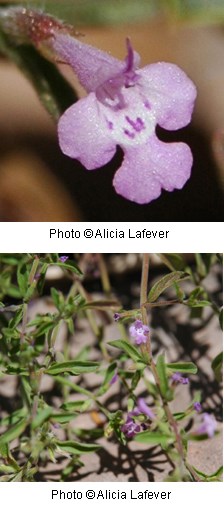
Hedeoma drummondii Family: Lamiaceae - (A Utah Flora – Labiatae) – Mint Family Aromatic annual or perennial herbs; stems 2.4” to 2' (0.6 to 6 dm) tall Leaves: opposite; simple; 0.2” to 0.56” (5 to 14 mm) long, 0.04” to 0.16” (1 to 4 mm) wide; usually no hairs on top of leaf, but there are hairs on underside of leaf Flowers: 1 to 5 flowers per cyme; 5 petals - corolla is 2-lobed on upper lip and 3-lobed on lower lip; corolla is purple to whitish in the throat; flowers 0.28” to 0.6” (7 to 15 mm) long; 5 toothed united sepals; 4 stamens; 1 pistil Pollinators: other genera in this family are pollinated by insects (specifically bees) Fruits: schizocarp Blooms in Arches National Park: May, June Habitat in Arches National Park: desert shrub and pinyon-juniper communties Location seen: near Wolfe Ranch Other: The genus name, “Hedeoma”, comes from the Greek “hedus” which means "sweet," and “osme” which means "odor" and is an ancient name for a strongly aromatic mint. The species name, “drummondii”, is named after Thomas Drummond (1790-1835), a Scottish naturalist who was with Sir John Franklin's Canadian Arctic expedition, and returned to become the curator of the Belfast Botanical Garden. |
Last updated: April 29, 2025
